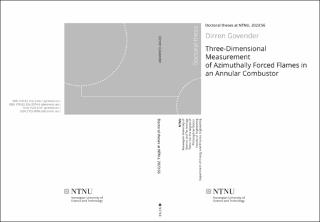| dc.contributor.advisor | Worth, Nicholas | |
| dc.contributor.advisor | Hearst, Jason | |
| dc.contributor.author | Govender, Dirren | |
| dc.date.accessioned | 2023-02-14T13:16:55Z | |
| dc.date.available | 2023-02-14T13:16:55Z | |
| dc.date.issued | 2023 | |
| dc.identifier.isbn | 978-82-326-5974-6 | |
| dc.identifier.issn | 2703-8084 | |
| dc.identifier.uri | https://hdl.handle.net/11250/3050748 | |
| dc.description.abstract | This thesis aims to better understand thermoacoustic instabilities in annular combustors. Thermoacoustic instabilities are a topic of interest since it is a challenge to operate gas turbines in a lean regime that reduces harmful emissions. Extensive research has gone into understanding thermoacoustics in single-flame burners. However, many gas turbines comprise of closely confined flames in an annular arrangement. Unlike single-flame burners, this configuration can give rise to azimuthal rather than axial modes, which subject flames to both azimuthal and axial pressure and velocity fluctuations. Previous studies have shown that the global Heat Release Rate (HRR) response varies depending on the nature or direction of these azimuthal modes, and the local flame response is often asymmetric, motivating the application of full three-dimensional methods. This thesis applies two different threedimensional diagnostics to better understand the response of flames in an annular combustor subjected to azimuthal modes.
The first method, Computed Tomography of Chemiluminescence (CTC), is applied to a single swirling flame in an annular combustor subjected to azimuthal spinning modes in the anticlockwise (ACW) and clockwise (CW) directions. When investigating the global HRR response, it was found that the flame response is the same irrespective of mode direction in the absence of flame-flame or flame-wall interaction. Three-dimensional analysis of the single flame, however, showed that the timing of the axial and azimuthal velocity fluctuations played a significant role in the flame response, thus providing insight into the mechanism behind the asymmetry.
Limitations of implementing the CTC method were highlighted, and a second three-dimensional technique, a new variant of Scanning Planar Laser Induced Fluorescence (PLIF), was developed and applied to overcome these drawbacks. This technique was used to study a single flame in a multi-flame annular combustor. The development of this technique is carefully outlined, with a complementary synthetic experiment that helped identify errors in the method. A bias error due to laser sheet orientation with respect to the flame was identified and was overcome by introducing a second orthogonal scan direction. The resulting technique was used to highlight asymmetries in the flame shape due to the annular confinement of an unforced flame without swirl.
Scanning PLIF was then applied in the investigation of the three-dimensional HRR response of flames with and without swirl subjected to spinning and standing modes respectively. In each case, the structure of the flames and the timing between the local phase and oscillation amplitude are identified. In terms of the flame response to standing modes, three cases are presented. A symmetric response is observed at the pressure antinode, whereas an asymmetric response is observed at the pressure node and an intermediate case between the pressure node and antinode. The Scanning PLIF technique is then applied to closely interacting flames subjected to ACW and CW spinning modes. The HRR response is seen to be dependent on the mode direction, as shown in previous studies, with a larger global HRR response to ACW as opposed to CW modes. Given access to the threedimensional HRR response field, it could be demonstrated that this was due to the timing between the axial velocity and azimuthal velocity fluctuations for the different cases, resulting in a phase shift in the local response in some regions of the flame.
The findings in this thesis help to better understand the flame response when subjected to azimuthal modes and this greater understanding will eventually enable better design of such combustors. This study also provides the necessary background into implementing three-dimensional techniques in annular combustion systems. | en_US |
| dc.language.iso | nob | en_US |
| dc.publisher | NTNU | en_US |
| dc.relation.ispartofseries | Doctoral theses at NTNU;2023:56 | |
| dc.relation.haspart | Paper 1: Dirren Govender, Hecong Liu, Fan Peng, Weiwei Cai, Nicholas A. Worth, Tomographic reconstruction of an azimuthally forced flame in an annular chamber, Proceedings of the Combustion Institute, 2022. This is an open access article under the CC BY license. | en_US |
| dc.relation.haspart | Paper 2: Govender, Dirren; Wiseman, Samuel; Dawson, James; Worth, Nicholas. Large volume scanning laser induced fluorescence measurement of a bluff-body stabilised flame in an annular combustor. Experiments in Fluids 2022 ;Volum 63. s. - This is an open access article under the CC BY license. | en_US |
| dc.relation.haspart | Paper 3: Govender, Dirren; Worth, Nicholas. Scanning PLIF measurement of azimuthally forced swirling flames in an annular combustor. Under review for Combustion and Flame. This paper is not yet published and is therefore not included. | en_US |
| dc.title | Three-Dimensional Measurement of Azimuthally Forced Flames in an Annular Combustor | en_US |
| dc.type | Doctoral thesis | en_US |
| dc.subject.nsi | VDP::Teknologi: 500 | en_US |

